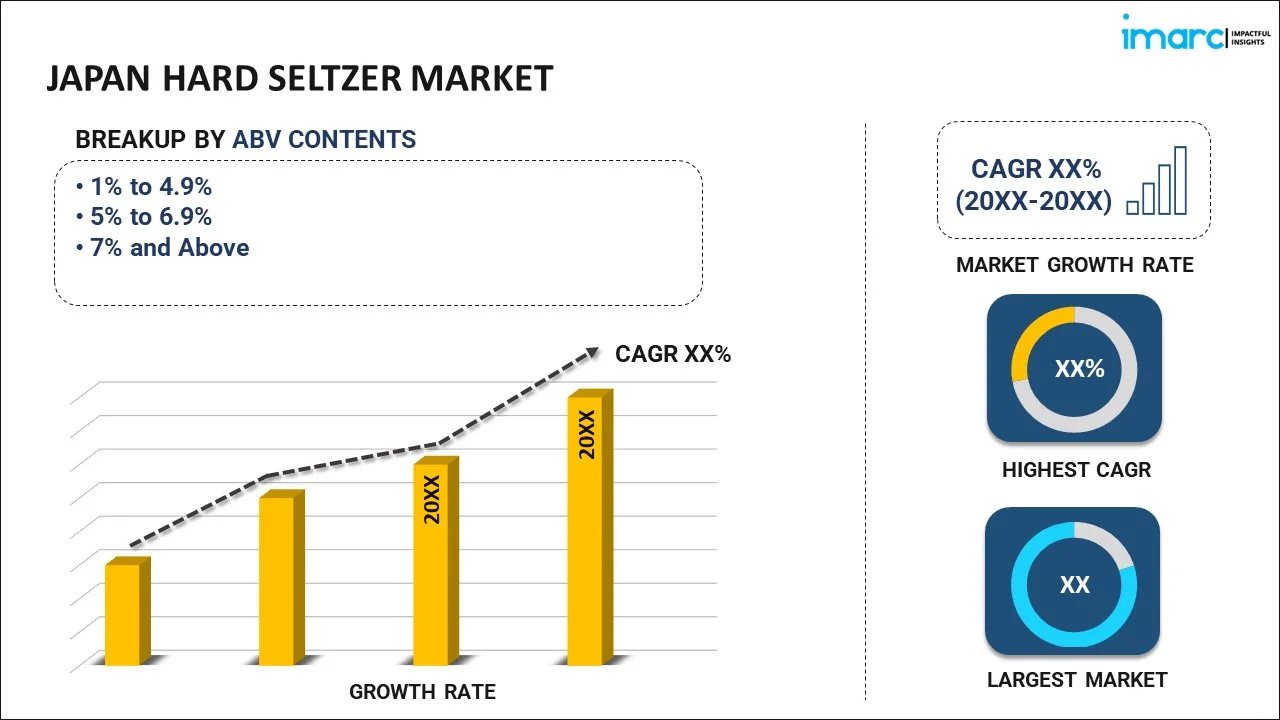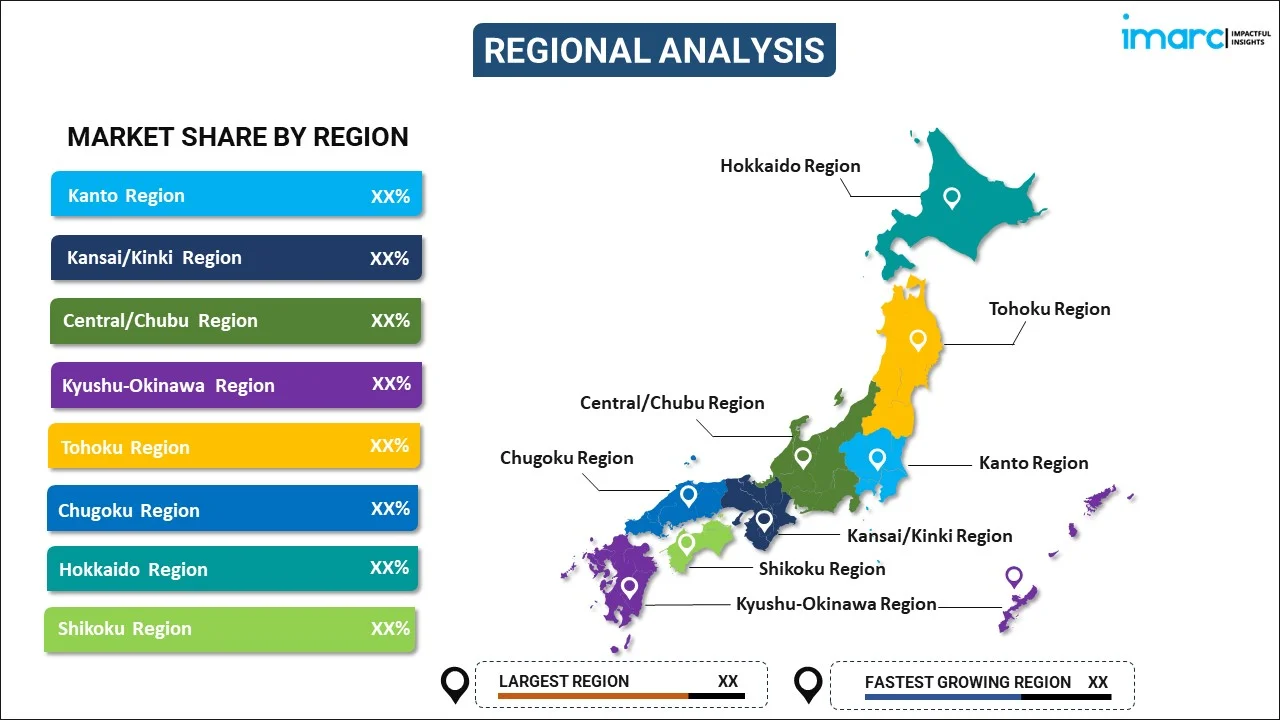
Japan Hard Seltzer Market Report by ABV Content (1% to 4.9%, 5% to 6.9%, 7% and Above), Packaging Material (Cans, Glass, and Others), Flavor (Cherry, Grapefruit, Mango, Lime, and Others), Distribution Channel (Supermarkets and Hypermarkets, Online Stores, and Others), and Region 2025-2033
Market Overview:
Japan hard seltzer market size reached USD 467.2 Million in 2024. Looking forward, IMARC Group expects the market to reach USD 1,033.0 Million by 2033, exhibiting a growth rate (CAGR) of 9.22% during 2025-2033. The growing consumer preferences and a desire for innovative, low-calorie alcoholic beverages, increasing demand for ready-to-drink beverages, which eliminates the need for complex mixology or extensive bar setups, and rising number of e-commerce beverage brands represent some of the key factors driving the market.
|
Report Attribute
|
Key Statistics
|
|---|---|
|
Base Year
|
2024 |
|
Forecast Years
|
2025-2033
|
|
Historical Years
|
2019-2024
|
| Market Size in 2024 | USD 467.2 Million |
| Market Forecast in 2033 | USD 1,033.0 Million |
| Market Growth Rate (2025-2033) | 9.22% |
Hard seltzer is a flavored alcoholic beverage typically made from carbonated water, alcohol, and flavorings. It is known for its light and crisp taste, low calorie and sugar content, and refreshing quality. It comprises a malt-based seltzer, which is made by fermenting malted barley and adding flavors and is like beer in the production process but results in a lighter, crisper beverage. It also consists of spirit-based hard seltzers, which are made by blending carbonated water with a clear spirit like vodka. It is available in a wide range of flavors, starting from classic fruit flavors like strawberry and black cherry to more exotic options like mango and passion fruit. It is often marketed as a healthier alternative to traditional alcoholic beverages due to its low calorie and sugar content. It is packaged in cans and is highly portable, making it convenient for outdoor activities and events where glass bottles might be impractical or prohibited. It appeals to individuals who may not have been traditional consumers of beer or spirits. Hard seltzer provides an inclusive option for those who may not enjoy the bitterness of beer or the strong flavors of traditional cocktails. It is widely available in various retail outlets, including grocery stores and convenience stores, enhancing its accessibility for consumers.
Japan Hard Seltzer Market Trends:
At present, the increasing health consciousness among the masses, along with the rising awareness about the harmful impacts of drinking alcohol regularly, represents one of the crucial factors impelling the growth of the market in Japan. Besides this, the increasing consumer preferences and a desire for innovative, low-calorie alcoholic beverages are contributing to the market growth. The appeal of hard seltzers as a guilt-free indulgence is leading to a shift in consumer choices, particularly among the younger demographic seeking a balance between enjoying alcoholic beverages and maintaining a healthy lifestyle. In addition, the growing availability of hard seltzers infused with natural ingredients and botanical extracts appeals to consumers seeking a departure from conventional alcoholic beverages. Key market players are also adopting influencer and social media marketing to connect with their targeted audience, gain insights into buyer preferences, and improve their sales. Apart from this, the increasing demand for ready-to-drink beverages, which eliminates the need for complex mixology or extensive bar setups, is supporting the market growth in the country. Consumers appreciate the grab-and-go convenience, making hard seltzers an ideal choice for various occasions, from picnics and outdoor events to casual gatherings at home. Additionally, the rising number of e-commerce brands selling various types of hard seltzers in innumerable flavors and delivering them to the doorstep of buyers is strengthening the market growth. Moreover, the increasing premiumization of hard seltzers, driven by a desire for unique and premium ingredients, as well as an emphasis on the overall aesthetic and packaging of the product, is bolstering the market growth.
Japan Hard Seltzer Market Segmentation:
IMARC Group provides an analysis of the key trends in each segment of the market, along with forecasts at the country level for 2025-2033. Our report has categorized the market based on ABV content, packaging material, flavor, and distribution channel.
ABV Content Insights:

- 1% to 4.9%
- 5% to 6.9%
- 7% and Above
The report has provided a detailed breakup and analysis of the market based on the ABV content. This includes 1% to 4.9%, 5% to 6.9%, and 7% and above.
Packaging Material Insights:
- Cans
- Glass
- Others
A detailed breakup and analysis of the market based on the packaging material have also been provided in the report. This includes cans, glass, and others.
Flavor Insights:
- Cherry
- Grapefruit
- Mango
- Lime
- Others
The report has provided a detailed breakup and analysis of the market based on the flavor. This includes cherry, grapefruit, mango, lime, and others.
Distribution Channel Insights:
- Supermarkets and Hypermarkets
- Online Stores
- Others
A detailed breakup and analysis of the market based on the distribution channel have also been provided in the report. This includes supermarkets and hypermarkets, online stores, and others.
Regional Insights:

- Kanto Region
- Kansai/Kinki Region
- Central/ Chubu Region
- Kyushu-Okinawa Region
- Tohoku Region
- Chugoku Region
- Hokkaido Region
- Shikoku Region
The report has also provided a comprehensive analysis of all the major regional markets, which include Kanto Region, Kansai/Kinki Region, Central/ Chubu Region, Kyushu-Okinawa Region, Tohoku Region, Chugoku Region, Hokkaido Region, and Shikoku Region.
Competitive Landscape:
The market research report has also provided a comprehensive analysis of the competitive landscape in the market. Competitive analysis such as market structure, key player positioning, top winning strategies, competitive dashboard, and company evaluation quadrant has been covered in the report. Also, detailed profiles of all major companies have been provided.
Japan Hard Seltzer Market Report Coverage:
| Report Features | Details |
|---|---|
| Base Year of the Analysis | 2024 |
| Historical Period | 2019-2024 |
| Forecast Period | 2025-2033 |
| Units | Million USD |
| Scope of the Report | Exploration of Historical and Forecast Trends, Industry Catalysts and Challenges, Segment-Wise Historical and Predictive Market Assessment:
|
| ABV Contents Covered | 1% to 4.9%, 5% to 6.9%, 7% and Above |
| Packaging Materials Covered | Cans, Glass, Others |
| Flavors Covered | Cherry, Grapefruit, Mango, Lime, Others |
| Distribution Channels Covered | Supermarkets and Hypermarkets, Online Stores, Others |
| Regions Covered | Kanto Region, Kansai/Kinki Region, Central/ Chubu Region, Kyushu-Okinawa Region, Tohoku Region, Chugoku Region, Hokkaido Region, Shikoku Region |
| Customization Scope | 10% Free Customization |
| Post-Sale Analyst Support | 10-12 Weeks |
| Delivery Format | PDF and Excel through Email (We can also provide the editable version of the report in PPT/Word format on special request) |
Key Questions Answered in This Report:
- How has the Japan hard seltzer market performed so far and how will it perform in the coming years?
- What has been the impact of COVID-19 on the Japan hard seltzer market?
- What is the breakup of the Japan hard seltzer market on the basis of ABV content?
- What is the breakup of the Japan hard seltzer market on the basis of packaging material?
- What is the breakup of the Japan hard seltzer market on the basis of flavor?
- What is the breakup of the Japan hard seltzer market on the basis of distribution channel?
- What are the various stages in the value chain of the Japan hard seltzer market?
- What are the key driving factors and challenges in the Japan hard seltzer?
- What is the structure of the Japan hard seltzer market and who are the key players?
- What is the degree of competition in the Japan hard seltzer market?
Key Benefits for Stakeholders:
- IMARC’s industry report offers a comprehensive quantitative analysis of various market segments, historical and current market trends, market forecasts, and dynamics of the Japan hard seltzer market from 2019-2033.
- The research report provides the latest information on the market drivers, challenges, and opportunities in the Japan hard seltzer market.
- Porter's five forces analysis assist stakeholders in assessing the impact of new entrants, competitive rivalry, supplier power, buyer power, and the threat of substitution. It helps stakeholders to analyze the level of competition within the Japan hard seltzer industry and its attractiveness.
- Competitive landscape allows stakeholders to understand their competitive environment and provides an insight into the current positions of key players in the market.
Need more help?
- Speak to our experienced analysts for insights on the current market scenarios.
- Include additional segments and countries to customize the report as per your requirement.
- Gain an unparalleled competitive advantage in your domain by understanding how to utilize the report and positively impacting your operations and revenue.
- For further assistance, please connect with our analysts.
 Inquire Before Buying
Inquire Before Buying
 Speak to an Analyst
Speak to an Analyst
 Request Brochure
Request Brochure
 Request Customization
Request Customization




.webp)




.webp)












